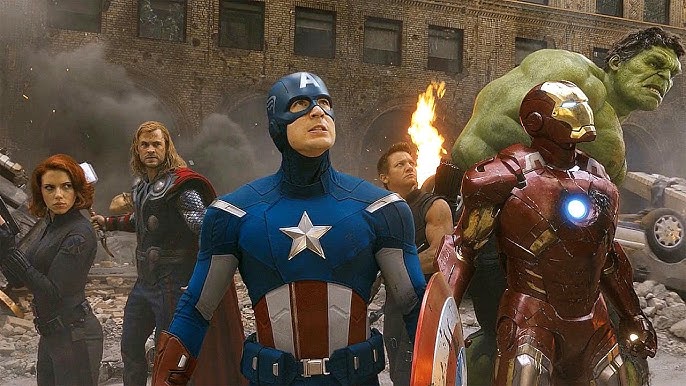There’s something uniquely powerful about the moment the Avengers team up for the very first time in the Marvel Cinematic Universe, or MCU. It’s not just how the music swells or how well done their characters are by the time it finally happens (although those elements are certainly a part of it). There’s another factor that makes this moment especially meaningful. Other team ups, across movies, TV shows, and books of all genres happen all the time, yet they simply don’t land as hard. I mean, an initial team-up is not always even intended to be an especially emotional moment in a story. Many times, it’s just something that needs to happen to move the plot along.
So today we’re exploring why certain moments like this one leave such an impact, and the steps you can take in your story before you even write your emotional moment to make sure it has the best shot of landing, and we’re doing it all by looking at The Avengers.
The Avengers
The Avengers is a movie centered around a major conflict known in the MCU as The Battle of New York. The Asgardian Loki has summoned the power of aliens he can hardly control in an effort to wage war on the people of earth, starting in New York City. SHIELD, knowing the attack is coming before it happens, sets out to find a group of heroes up to the task of facing this force and possibly stopping a world-wide invasion.
As viewers, many of us have met these characters before. Steve Rogers, otherwise known as Captain America, has gotten an entire movie devoted to his origin story as a soldier-turned-superhero during World War Two. Iron Man, Thor, and the Hulk have also been featured in their own origin films, and HawkEye and Black Widow serve as major supporting characters in these movies. We’ve watched each of these characters grow and develop. We met Thor as essentially an overpowered and immature teenager, and watched him grow into a person worthy to wield one of the most powerful weapons in both his world and ours. We saw Captain America grow from a well-meaning but naive idealist to someone who has been to war and back again. Even Black Widow has expanded her role from a SHIELD agent meant to keep an eye on Iron Man to a skilled operative able to hold her own beside superheroes with incredible powers and technology.
We watched all of this happen without the word “Avengers” even gracing the dialogue between the characters. It’s been a total of four years since the first Iron Man movie kicked off the MCU, and viewers spent the entire time waiting in anticipation for the moment they knew the heroes would first assemble. The writers spent the films in between introducing the characters, posing the clear need for a unified, competent team of protectors, and providing the necessary backstory for the major villain of the movie.
By the time the Avengers assemble for the very first time, we aren’t just watching a team join up, but instead individuals we know personally unite around a common goal for the first time. The reason this moment hit so hard is because of our third principle for writing emotional scenes:
Buildup makes it matter.
Buildup Makes It Matter
One of the biggest things that cheap dramas lack is proper buildup. The scenes that many writers will hope lands as a shock or plot twist instead come across as cheap and under-developed. If you’re going to write an emotional scene with one or more of your characters, you can’t dump it on the audience and trust they’ll feel its full weight. Instead, intentionally place markers that this moment — whether it’s one of division, unity, happiness, anger, or surprise — will happen eventually. You have to think of these emotional moments like bombs set to go off any second. Your readers don’t have to know when they’ll explode, but they should notice they are there and subconsciously realize there’s no way to diffuse them. One time or another, they will go off.
The rising threats to earth throughout the first few films in the MCU were clear indications that an impactful moment was just around the corner. These threats became harder and harder to ignore as both the audience and characters gradually began to realize that assembling a team to protect earth would become imperative. The audience began to anticipate this moment, building suspense and tension that was finally released in a burst of emotion as the Avengers joined forces at the Battle of New York for the first time.
A big part of the reason the other emotional moments we’ve mentioned in this series worked is because there was significant, intentional buildup for them almost as early on as possible. In Ant Man, Scott Lang’s relationship with his daughter is introduced in the first few minutes of his time on screen, hinting that the father-daughter theme will take prominence throughout the film. Each of the emotional moments between Jemma and Fitz as they wrestle through their relationship had significant buildup, often across multiple seasons.
And this is one of the most consistent principles seen across the early Marvel movies, which is one of the biggest reasons that they were so successful. Very, very early on they set up plot points, characters, and plot devices that had an obvious and inevitably emotional tie to the story. Just one example of this is the fact that Thanos was introduced in the post-credits scene of the Avengers movie, and the payoff of that introduction was only begun six years later, in Avengers: Infinity War.
On the other hand, failing to recognize the power of this principle is one of the fastest ways a movie can fail. The DC Extended Universe is one example of this. Even though Zack Snyder’s Justice League was decently well-written (although severely long-winded), it lacked the impact of the early Avengers movies because the moment the Justice League united for the first time wasn’t earned. We hadn’t seen many of the characters interact on their own, and few of them got the feature-long-film treatment of the majority of the original Avengers. The threat they were facing hadn’t been built up throughout multiple films as Loki had been, and so it was difficult to feel the need for a team of heroes the same way. Seeing the Justice League unite for the first time was interesting, but far from as impactful as the Avengers had been.
If you want your emotional scenes to land, you have to build toward them, like a crescendo in music that you know is pointing toward a climax.
But once you do that, it becomes almost easy to write emotional scenes with impact. If you refuse to give away more than you have to, instead saving your emotional moments for the climax of the buildup you’ve been planning, you’ll come away with a moved audience willing to hang on to your every word. That’s because they know each detail will turn out significant, and even though it might not appear that way at first, that’s only because it’s pointing to a greater moment still yet to come.
It’s been said that anticipation is half the fun, but anxiety is also often the worst part of an impending threat. No matter what kind of emotional outburst you’re planning, intentional buildup will ensure that your audience not only sticks around to see it through, but also feels its true impact right along with your characters.



Let us know in the comments:
What other meaningful moments have you noticed hit hard because of their buildup? What buildup are you including in your own story?


Hi! My name is Mara, and I’m a Christian artist, violinist, and blogger. I remember the day that I decided that I would learn something new about what makes a good story from every book I picked up — whether it was good, bad, or a mixture of both. I use this blog as a way of sharing some of the tips and tricks I’ve learned, and highlight which books, cartoons, and movies have taught me the most about writing an awesome story.


How does one build up a plot twist?
That’s a really good question!
One way you could consider doing this is by having a perspective character who knows the plot twist is coming. I think we as authors often underestimate the power that anticipation can have — and that sometimes it can even generate a greater emotional reaction than surprise!
Another way is by dropping hints that something isn’t right without telling exactly what’s wrong. Have a character say something that seems a little strange, but don’t let the other characters think about it too much, and don’t have it come up too often.
Building up to a plot twist is all a balance between giving it away and planting enough hints that make it seem obvious on the other end. That balance can be tricky and is probably worth a whole article itself!